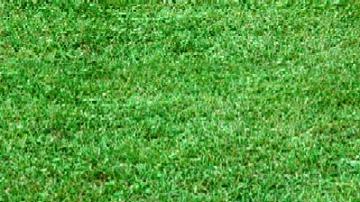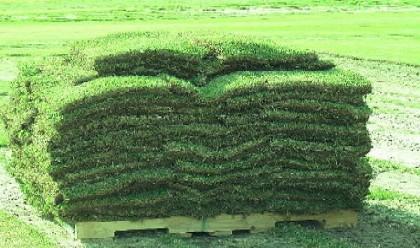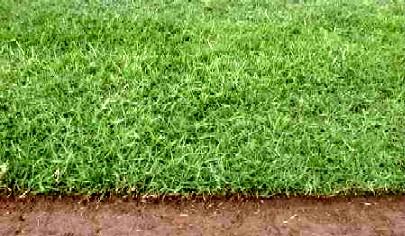Bermuda Grass Sod
Sod vs. Seed
Bermuda grass sod also known as Bermuda Sod are created mainly out of hybrid grass or some times from improved common varieties. These sods are cut-outs of Bermuda Grass beds where grass along with a layer of soil below are held together by the root system. The hybrid Bermuda grasses do not produce seed and are propagated by vegetative method like sod.
The hybrids are very fine in texture and more expensive than common varieties such as Sahara. Bermuda sod requires extensive care and maintenance for growth and development.
So why and when will you use Bermuda grass sod instead of seed?
Bermuda seeds take time (about 7 to 10 days) to germinate and then 60 to 90 days to get fully established. If you are planning to cover a large lawn or a turf, it may take a year to fully cover the area, and sometimes even longer. Also, the grass grown out of the Bermuda seed may not be very dense and uniform as you usually see in the greens of golf courses.
Typical Bermuda Sod Grass
Bermuda sods on the other hand, provide almost an instant coverage with green grass. It can take only 2 to 3 weeks to fully establish an average lawn. Sods come in form of rolls (of 10 square feet size each), pallets (i.e. stacks that can cover 450 square feet each) or even pieces (3 square feet each). The sod quickly takes root in the lawn to produce dense and lush green coverage.
While Bermuda seed can be sowed only from mid-May to mid-August, Bermuda sod can be laid out throughout the year until the time the ground starts to get frozen. However, for best results, Bermuda sod should be laid out from mid-March to November.
Bermuda Sod Stack
Types of Bermuda Sod
Out of the improved common varieties of Bermuda Grass, Ormond and Tifdwarf are often used as Bermuda Sod. However, hybrids are the best for sods.
Here are some of the hybrid types used in Bermuda Sod.
Tifway Bermuda (T-419) is a super sod. The color of the grass is dark green with medium fine textured leaves. It is a dense grass with a medium to low growth. However, the growth of this variety is quick. It grows best in hot climates when soil pH is between 6.5 and 7.2.
It remains dormant after frosting. It is drought tolerant. With proper maintenance it can also recover from pest damage. It's generally propagated as sprigs or as sod. This type is commonly used on golf course fairways and tees, sport fields and in landscapes.
Tifway Bermuda Grass
Other hybrids that are commonly used as Bermuda sod include: Tifgreen, Tifgreen-II, Tiflawn, Floratex and such. There are lot more varieties of hybrid types that are also used as Bermuda sod. You should check with your local sod retailer and find out the best match for your soil type.
Find out the most popular hybrids that make great Bermuda sods:
Bermuda Hybrids
Average Cost
The indicative cost of Bermuda Sod (depending on its type) is:
$0.30 to $0.85 per square feet. Note, each piece is 3 square feet (i.e. 16 inch x 24 inch).
$3.00 to $9.00 per roll. Each roll is 10 square feet (i.e. 24 inch x 64 inch)
$150 - $180 per pallet. Each pallet is 450 square feet (stacks of 4ft x 4ft x 4ft)
Note that if you want to get the lawn established by a third party professional, approximate cost of laying sod including soil preparation, delivery and laying would cost $1 - $2 per square feet.
If you want to arrive at the total cost of sodding your lawn area, then you need to first calculate the total square feet area of your lawn and then multiply that with the rate. If your lawn area is not exactly square or rectangular and has an irregular shape, then a good way to go about this to identify the main area which can be marked as rectangular, and then divide the remaining difficult areas into smaller triangles and rectangles or even circles.
Area of a square or rectangle = Length X Width
Area of a triangle = (Height X Base) / 2
Area of a circle = 3.14 X Radius X Radius
How to lay Bermuda Sod
If you are an experienced landscaper, a DIY approach would certainly save you about 50% of the total cost. Otherwise, you can consider engaging a professional landscaper who with their experience and knowledge as well as appropriate equipment, can produce high quality work. They will also know which sod type will be best for the type of soil and other environmental conditions of your lawn.
Characteristics of Bermuda Sod
When you compare Bermuda Sod with other types of grass sods, there are several differences in their characteristics. One of the major strengths of Bermuda Sod is its traffic tolerance which is the highest amongst all types of sods and is certainly higher than sods of St. Augustine, Zoysia and Kentucky Bluegrass and is similar to that of Tall Fescue.
However, when it comes to weed and pest resistance, then Zoysia sod is the most resistant type compared to all others. Bermuda sod has average weed and pest resistance which is similar to that of St. Augustine and Tall Fescue but higher than Kentucky Bluegrass.
When you compare the look, Bermuda Sod has fine blades, while Zoysia can have both broad and fine blades, St. Augustine has mainly broad blades, and both Tall Fescue and Kentucky Bluegrass have fine blades. Bermuda grass is seasonally dormant (in winter).
And finally, in terms of cost, while average cost of Bermuda Sod Roll is $3 - $9, the average cost of sod roll of Zoysia and St. Augustine is $3 - $8, Fescue is $4 - $7, Kentucky Bluegrass is $3 - $6, Perennial Ryegrass is $4 - $10, and Centipede is $4 - $9.
Watering Bermuda Sod
The best time to water an already established and sodded lawn is during the morning time. This allows the grass to dry before nightfall, reducing the risk of disease.
However, for new Bermuda sods that have been just laid and the root system is yet to establish in the lawn, follow the steps as mentioned below:
1. Apply one inch of water immediately after the sod is laid.
2. Water the sod daily and ensure that the top one inch of soil is kept moist. This needs to continue until the sod is rooted to the soil
3. After that, apply one-fourth inch of water every third day for nine days.
4. Next apply one-half inch of water every fifth day for ten days.
5. After the sod is established, apply one inch of water per week for the rest of the growing season.
6. You should also consider rainfall before deciding how much of water to apply
|
 By Raj Bhattacharya By Raj Bhattacharya
Raj, a seasoned travel writer and Bermuda destination expert, has extensive global travel experience. This website reflects his profound insights, garnered over nearly two decades of dedicated findings and research on the island. Raj has assisted countless Bermuda-bound visitors by providing direct, personalized responses to their queries and imparting his wealth of knowledge through this platform. This site serves as an indispensable guide for those seeking informed and reliable insights into Bermuda's treasures.
|
Related Articles
|
Viewers' Reviews and Comments
Elizabeth l Cartin (October 2014)
Just moved and would like to finish yard. I live in central South Carolina and wondering if it is too late to put Bermuda sod down. If it isn't, how often should I water it and for how long. It is the middle of October so wasn't sure about this.
Raj (bermuda-attractions.com) October 2014
Hi, Bermuda Sod can be laid any time in the year. However for best results, you should lay the sod between mid-March and November. So it's not late. For watering, go through the section 'Watering new Bermuda Sod'.
|



 By Raj Bhattacharya
By Raj Bhattacharya